КОМПЛЕКСНОЕ ИСПОЛЬЗОВАНИЕ ЭНЕРГИИ ВОЗОБНОВЛЯЕМЫХ ИСТОЧНИКОВ В РЕГИОНАХ ТУРКМЕНИСТАНА
Джумаев А.Я.1, Сарыев К.А.2, Джумаев Б.А.3
1ORCID: 0000-0002-2297-1989, кандидат физико-математических наук, 2ORCID: 0000-0002-0724-8397, соискатель, 3ORCID: 0000-0003-1580-5824, аспирант,
Государственный энергетический институт Туркменистана, г. Мары, Туркменистан
КОМПЛЕКСНОЕ ИСПОЛЬЗОВАНИЕ ЭНЕРГИИ ВОЗОБНОВЛЯЕМЫХ ИСТОЧНИКОВ В РЕГИОНАХ ТУРКМЕНИСТАНА
Аннотация
Наличие устойчивого и надежного электропитания играет важную роль, определяя энергетическую дорожную карту области. Это может быть достигнуто через различные методы. В нашей работе мы проанализировали гибридную электростанцию, которая состоит из двух возобновляемых источников энергии: солнечный и энергия ветра. Гибридная электростанция установлена на и посвящена для экспериментального дома, который построен на территории нашего института. Кроме того эта бумага включает ценную информацию о солнечном коллекторе, который стремится снабжать жителей горячей водой. В пределах исследования непрерывно наблюдались поведения и особенности установленного оборудования. Информацией, полученной от гибридной электростанции, может быть модель и центр внимания для дальнейших осуществляющих возобновимых электростанций в Марыйской области Туркменистана.
Ключевые слова: возобновляемые источники энергии, гибридная электростанция, устойчивое электропитание, эффективность использования энергии, солнечный коллектор.
Jumayev A.Y.1, Saryyev K.A.2, Jumayev B.A.3
1ORCID: 0000-0002-2297-1989, PhD in Physics and Mathematics, 2ORCID: 0000-0002-0724-8397, Postgraduate student, 3ORCID: 0000-0003-1580-5824, Postgraduate student,
State Energy Institute of Turkmenistan, Mary, Turkmenistan
COMPLEX USAGE OF RENEWABLE ENERGY SOURCES IN THE REGIONS OF TURKMENISTAN
Abstract
Having stable and reliable power supply plays an important role while defining the energy roadmap of the region. This can be achieved through various methods. In our work we analyzed a hybrid power station which consists of two renewable energy sources: solar and wind energy. The hybrid power station is mounted on and dedicated for an experimental house that is built in the territory of our institute. Moreover, this paper includes a valuable information about a solar collector which aims to supply residents with a hot water. Within the research, behaviors and characteristics of installed equipment were continuously observed. The information gained from the hybrid power station can be a model and a spotlight for further implementing renewable power stations in Mary region of Turkmenistan.
Keywords: renewable energy sources, hybrid power station, stable power supply, energy efficiency, solar collector.
Introduction
Discrete and periodic behavior of its sources or inconsistent accessibility to energy potential is one of the reasons for limited usage of renewable energy sources (RES). Thus, in many cases their usage results in difficulty and does not support required parameters of energy demand. At State Energy Institute of Turkmenistan (SEIT) there are being carried out scientific and technical researches related to main directions of renewable energy sources and system of energy accumulation. The accumulators are used to compensate the renewable energy loss or shortage and they guarantee the reliability of energy supply system. As a result, the efficiency of the system increases.
The aim of this research was to compute efficiency of the hybrid power station, located in Mary region, and to define optimum parameters of the station.
Complex power systems based on RES
At the State Energy Institute of Turkmenistan there was prepared a complex power system and energy accumulation system based on RES. The system was subjected to numbers of scientific-research works. As a result, there was built an experimental living house with independent energy and hot water supply. Efficiency of usage was calculated for different kinds of complex power systems based on RES in various climatic zones of Turkmenistan. Among them more appropriate system is shown below in Fig. 1 and Fig. 2.
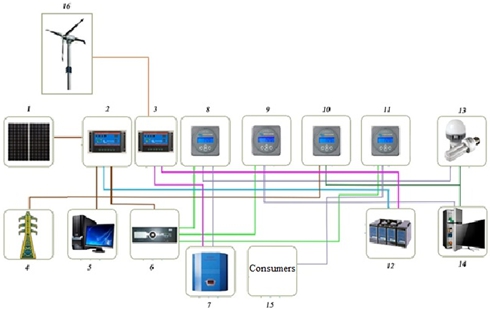
Fig. 1 – Schematic drawing of the complex power system
Schematic drawings of the consisting elements and working principle of the complex power system, used to provide energy and hot water supply, are shown in the Fig. 1 and Fig. 2.
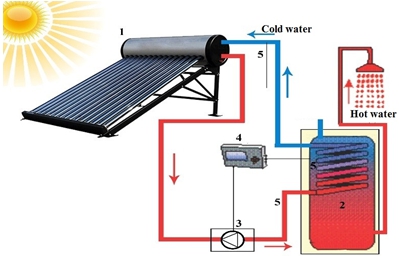
Fig. 2 – System of hot water supply
The complex or hybrid power system includes following elements: photoelectrical power station (PPS) 2 kW of power gain and wind power station (WPS) each with 2 kW of power gain, solar panels with active area of 1.6 m2, electro-chemical accumulating batteries with 200 A*h of capacity (8 pieces). Technical parameters and elements of PPS are shown on Table 1. Photoelectrical power station contains 16 pieces of solar panels each with 130 Watts of power output, controller, invertor and 8 pieces of accumulators each having 200 A*h capacity. Similarly, technical parameters and elements of WPS are shown on Table 2. WPS contains L-2000 wind installation and hybrid controller. Technical characteristics of the system of hot water supply are shown on Table 3.
As a result of carried out experiments, scientific research and number of calculations, optimal operating regimes or classes of such power systems were defined. Our calculations show that under constant angle of inclination annual solar energy per 1m2, coming to solar panel, was around 2040.1 kW*hour. Whereas this results was 2164.9 kW*hour if the angle of inclination was changed twice a year. The angle was different during summer season than it was during winter season. Obviously, there is no so much difference between these various power outputs. Therefore, it is economical to build a solar power station with fixed angle of inclination. In our case, optimal angle of inclination was chosen to be 360 directed to South. Because the efficiency of solar panel is only 16%, under fixed angle, solar panel annually generates around 326 kW*h (16% of 2040.1 kW*hour) [1, P. 20-22].
As shown in Fig. 1, hybrid power generating system consisting of solar and wind power stations generates electrical energy, which afterwards is delivered to consumers through an automated system designed for controlling the regimes of this power system [2, P. 12-18]. Firstly, accumulating batteries are charged which are then used to supply lamps and appliances with electrical energy.
Table 1 – Technical parameters and including elements of PPS
| Electrical and Mechanical Data | Remarks |
| Solar module, Canadian Solar | Model type: CS6C-130 |
| Quantity solar modules | 16 |
| Nominal Maximum Power (Pmax) | 130 W |
| Optimum Operating Voltage (Vmp) | 17.6 V |
| Optimum Operating Current (Imp) | 7.38 A |
| Open Circuit Voltage (Voc) | 22.1 V |
| Short Circuit Voltage (Isc) | 7.95 A |
| Maximum System Voltage | 1000 V |
| Maximum Series Fuse Rating | 15 A |
| Fire Rating | CLASS C |
| Application Class | CLASS A |
| Operating Temperature | -400 - + 800 C |
| Power Tolerance | ±5 W |
| Dimensions | 1485x666x40 mm |
| Weight | 12.0 kg |
| Solar Power Controller | LB01, PWM 01, 2 kW, 48V, 60 A |
| Power Inverter | YGDY, 2.5 kW, 1.2 kW |
| Quantity Solar Battery, VRLA Gel, 200 A•h, 12 V | 8 |
Table 2 – technical parameters and elements of WPS
| Electrical and Mechanical Data | Remarks |
| Wind station L-2000 | Model: WWS20-48-NOO |
| Rated power (W) | 2000 |
| Rated voltage (V) | 96 |
| Wheel diameter (m) | 3.3 |
| Start up wind speed (m/s) | 3 |
| Rated wind speed (m/s) | 10 |
| Survival wind speed (m/s) | 45 |
| TOP NG (kg) | 48 |
| Body material | Casting aluminum |
| Blades material | Reinforced glass fiber |
| Generator | Three phase AC permanent magnet generator |
| Number of blades | 3 |
| Protection | Electronic magnet/mechanic furling |
| Lubrication | Lubrication grease |
| Working temperature | -400 – +800 C |
| Tower type | Guyed tower |
| Wind/solar Hybrid Controller | 1 |
| Rated battery Volt | 48 VDC |
| Rated Wind Power | 2 kW |
| Rated PV Power | 0.6 kW |
| Dump-load Voltage | 58 V |
| Wind Brake Current | 42 A |
Table 3 – technical parameters of hot water supply system
| № | Parameters with their units | Remarks |
| 1 | Solar collector, vacuum tubes, mm | 58x1800 |
| 2 | Size of the solar collector, mm | 1880x280x240 |
| 3 | Size of the reservoir, mm | 1160x490x490 |
| 4 | Effective area of the solar collector, m2 | 1.6 |
| 5 | Amount of vacuum tubes | 12 |
| 6 | Amount of solar collectors in the system | 1 |
| 7 | Type of the absorber | Vacuum tube |
| 8 | Capacity of the reservoir, liters | 200 |
| 9 | Type of the solar collector | SR-868C6 |
| 10 | Minimum temperature of the environment, 0C | From 0 down to -20 |
| 11 | Type of the pump | Wilo RS 25/6 |
Solar collectors are mainly used in order to maintain the hot water demand and because demand for hot water to be used in household stuffs decreases during hot weather, especially in summer season, it can be used in a cooling system of a house [7, P. 234].
Working principle of such solar collectors is simple and analogous with traditional central heating system. It is a closed system, thus a liquid takes away heat from the copper tips which are heated up to temperature 350-380 0C, and then a hot liquid are pumped over through a coil of the accumulator and heats up water.
Cycle of transforming heat energy from collector into electrical energy and storing it in accumulator takes place during daytime. Operation of the pump is controlled by electronic controller which follows the command of the system. Thermal sensors are located in the collector and accumulator which is used to show the temperature of the system. Other than this, expansion container protects the system from extra high pressure, which occurs when the hot water is not used for a long time and as a result of rise in temperature.
In the given system temperature control in the solar collector and in the storage container plays an important role. Moreover, depending on the range of temperature, an optimum operating mode of the system is another significant issue. Dedicated for these purposes, the controller fulfills the basic functions, regulates a heat-carrier stream through the heat exchanger and defines the direction of heat flow. In order to circulate the heat, it is necessary to use the pump [8, P. 276]. This pump is controlled by sensors automatically. Because the rate of the water flow in the system does not exceed 2 liters per minute, a pump, working with a relatively low power, is enough to overcome this task.
Energy parameters and monitoring performance of the power installation
The experimental living house is located in State Energy Institute of Turkmenistan, in city of Mary (geographical coordinates: 37.60 North, 61.80 East). Solar panels are located on the roof of this experimental house and directed to South with 360 of angle of inclination [2, P. 12-18].
Technical characters and features of the system of hot water supply based on solar collector is shown on the Table 3.
In order to define the efficiency of using the solar collector, calculations of key parameters of hot water supply have been carried out. In addition, it was computed the amount of power gain through the solar collector.
While calculating the falling solar energy, the database of NASA has been used. Moreover, Louis-Gordon method was used to compute the average solar radiation towards the inclined surface [3, P. 80-92]. The results of these calculations can be seen on Table 4. In parallel with the data of NASA related to solar collector having 360 of inclination, during a daytime average amount of solar energy falling to the surface of 1 m2 is around 5.58 kW*h, while it is 271.33 kW*h within a month.
The efficiency of the solar collector is estimated to be almost 60%. Under these conditions, average thermal energy developed by the solar collector, having 1.6m2 of active area, becomes 162.8 kW*h.
Table 4 – Useful thermal energy (kW*h) which can be obtained by the solar collector
| Month | Direct solar radiation falling on 1m2 of surface per day | Solar energy falling on 1m2 of inclined surface (with 360 of inclination) per day | Solar energy falling on 1m2 of inclined surface (with 360 of inclination) per month | Developed thermal energy per month (1.6 m2) | Monthly demand for hot |
| January | 2.30 | 4.59 | 227.66 | 136.6 | 160 |
| February | 3.25 | 5.37 | 240.58 | 144.35 | 160 |
| March | 4.10 | 5.44 | 269.82 | 161.89 | 160 |
| April | 5.22 | 5.61 | 269.28 | 161.57 | 160 |
| May | 6.33 | 5.87 | 291.15 | 174.69 | 140 |
| June | 7.0 | 6.08 | 291.84 | 175.10 | 120 |
| July | 6.93 | 6.22 | 308.51 | 185.11 | 120 |
| August | 6.27 | 6.31 | 312.98 | 187.79 | 120 |
| September | 5.21 | 6.36 | 305.28 | 183.15 | 120 |
| October | 3.75 | 5.77 | 286.19 | 171.71 | 140 |
| November | 2.66 | 5.04 | 241.92 | 145.15 | 140 |
| December | 2.02 | 4.25 | 210.8 | 126.48 | 140 |
| Annually developed thermal energy by the solar collector: 1953.59 | 1680 | ||||
Researches of influence of environmental conditions, i.e. influence of cloudy weather, air dust content on operational parameters of photoelectric power station are conducted, and also low power characteristics of sunlight during winter time demand the overestimated capacities of converters of solar energy that leads to their inefficient use during the summer period, i.e. summertime accumulators are quickly charged and therefore the controller disconnects charging process of the accumulator [4, P. 496], [5, P. 62-66]. Dynamics of charging process of accumulators during the summer period is shown in Fig. 3 and Fig. 4. As it can be seen from these figures, on sunny days the accumulators are quickly charged up, therefore when they reach the peak point, the controller disconnects them from the circuit. Otherwise, accumulators will get seriously damaged [9, P. 96], [10, P. 75].
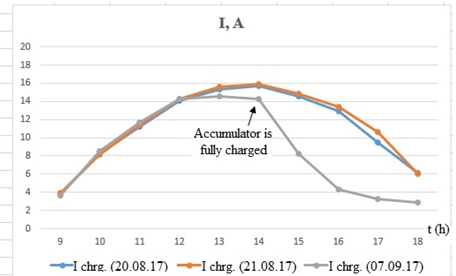
Fig. 3 – Variations of charging process depending on loads connected to the system
As a result, the efficiency decreases. The graph in Fig. 3 shows the variations of electrical current as loads are connected to the system before and after 12:00 AM. In the Fig. 4, depending on consumers of electrical energy, it is shown how fast the accumulators charge up during night time.
Experimental data has shown that during the demand of electrical energy higher than 6 kW*h at night, four accumulators connected in series operates with higher efficiency. Monitoring fragment of electrical energy demand within a month is shown in Fig. 5.
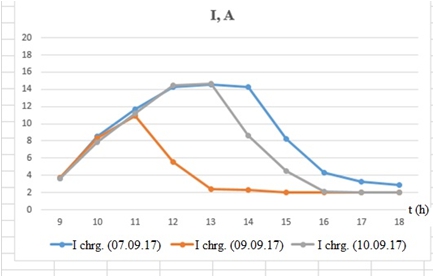
Fig. 4 – Variations of charging process of accumulator during different conditions of energy consumption
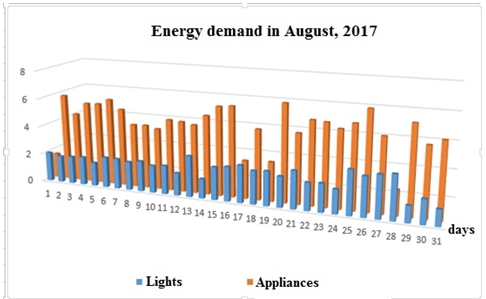
Fig. 5 – Monitoring fragment of electrical energy demand within a month
Annual operation of such complex power supply system in Mary region of Turkmenistan have shown that complex power systems for inhabited and industrial targets at the configuration corresponding to the given climatic zone, and at the account of all factors stated above such systems are effective enough in operation on all territory of Turkmenistan [6, P. 255].
After defining optimum usage of the equipment used in complex power plant, it can be concluded that the system cannot be operated at fully autonomous regime during winter season, while this can be achieved during summer season in Mary and Lebap region of Turkmenistan.
Conclusions
- Complex power systems for inhabited and industrial targets at the configuration corresponding to the given climatic zone, and at the account of all factors stated above such system is effective enough in operation on all territory of Turkmenistan.
- Optimum angle of inclination of solar panels, located in city of Mary, from horizontal surface is calculated to be 170 during summer season while it is 610 during winter season. In case of fixed angle of inclination, the optimum angle was estimated to be 360 from horizontal surface. Under fixed angle of inclination, solar panel annually generates around 326 kW*h of electrical energy per 1m2 of effective area.
- Researches show that using solar collectors, to supply consumers with hot water, is so effective that it decreases former expenses by 70%.
- The data of the researches proves the importance of using solar collectors as an alternative energy resource. In connection with inevitable growth of tariffs for electrical or thermal energy and the prices of fuel, and also aspiration of consumers to increase reliability of a heat supply at the expense of creation of own sources of thermal energy, usage of solar collectors will steadily increase.
Список литературы / References
- Джумаев А. Я., Кадыров Э. Д. Исследование эксплуатационных параметров фотоэлектрической солнечной станции в условиях Туркменистана / А. Я. Джумаев, Э. Д. Кадыров // Автоматизация в промышленности. – 2015. – №11. – С. 20-22.
- Джумаев А. Я., Кадыров Э. Д. Автоматизированная система управления автономным энергоснабжением / А. Я. Джумаев, Э. Д. Кадыров // Автоматизация и ИT в энергетике. – – №12(89). – С. 12-18.
- Jumayev A. Scientific-technical and methodological aspects of an estimation of resources of solar energy in Turkmenistan / A. Y. Jumayev // International Conference on European Science and Technology: materials of the XI international research and practice conference. Munich: October 21-22, 2015. – P. 80-92.
- Стребков Д. С. Развитие солнечной энергетики в Туркменистане / Д. С. Стребков, А. М. Пенджиев, Б. Д. Мамедсахатов. – М.: ГНУ ВИЭСХ, – 496 с.
- Пенджиев А. М., Мамедсахатов Б. Д. Основные условия и факторы развития фотоэнергетики в Туркменистане / А. М. Пенджиев, Б. Д. Мамедсахатов // International Scientific Journal for Alternative Energy and Ecology. – 2007. – №7(51). – C. 62-66.
- Nourqolipour R., Komaki C. B. Planning the best locations for solar electric generating systems in Turkmenistan / R. Nourqolipour, C. B. Komaki // Science, Technology and Innovative Technologies in the prosperous epoch of the powerful state. – Ashgabat : Ylym, 2015. – 255 p.
- Лосюк Ю. А., Кузьмич В. В. Нетрадиционные источники энергии / Ю. А. Лосюк, В. В. Кузьмич. – Мн.: УП «Технопринт», 2005. – 234 с.
- Batukhtin A. G. Development of the method heat supply increase with the use of heat exchange efficiency / A. G. Batukhtin, S. G. Batukhtin, P. G. Safronov, M. G. Baranovskaya // European Science and Technology. – 2015. – Vol. 2. – P. 275-279.
- Solanki C. S. Solar photovoltaic technology and systems / C. S. Solanki. – Delhi: PHI Learning Private Limited, 2016. – 96 p.
- Solanki C. S. Solar Photovoltaics: Fundamentals, technologies and applications / C. S. Solanki. – Delhi: PHI Learning Private Limited, 2015. – 75 p.
Список литературы на английском языке / References in English
- Jumayev A. , Kadyrov E. D. Issledovaniye ekspluatasionnyh parametrov fotoelektriceskoy solnecnoy stansii v usloviyah Turkmenistana [Research on implementation parameters of photoelectrical solar station under conditions of Turkmenistan] / A. Y. Jumayev, E. D. Kadyrov // Awtomatizasiya v promyshlennosti [Automation in industry]. – 2015. – №11. – P. 20-22. [in Russian]
- Jumayev A. Y. Kadyrov E. D. Awtomatizirowannaya sistema uprawleniya awtonomnym enegosnabzeniyem [Automatical control system of autonomous energy supply] / A. Y. Jumayev, Kadyrov E.D. // Awtomatizasiya i IT v energetike [Automation and IT in power engineering sector]. – 2016. – №12(89). – P. 12-18. [in Russian]
- Jumayev A. Scientific-technical and methodological aspects of an estimation of resources of solar energy in Turkmenistan / A. Y. Jumayev // International Conference on European Science and Technology: materials of the XI international research and practice conference. Munich: October 21-22, 2015. – P. 80-92.
- Strebkov D. S. Razvitie solnechnoy energetiki v Turkmenistane [Development of solar energy in Turkmenistan] / D. S. Strebkov, A. M. Penjiyev, B. D. Mamedsahatov. – М.: GNU VIYeSH, – 496 p. [in Russian]
- Penjiyev A. M., Mamedsahatov B. D. Osnovnie uslovie i faktory razvitiya fotoenergetiki v Turkmenistane [Main conditions and factors of developing photoenergy in Turkmenistan] / M. Penjiyev, B. D. Mamedsahatov // International Scientific Journal for Alternative Energy and Ecology. – 2007. – №7(51). – P. 62-66. [in Russian]
- Nourqolipour R., Komaki C. B. Planning the best locations for solar electric generating systems in Turkmenistan / R. Nourqolipour, C. B. Komaki // Science, Technology and Innovative Technologies in the prosperous epoch of the powerful state. – Ashgabat : Ylym, 2015. – 255 p.
- Losyuk Y. A., Kuzmich V. V. Netradisionniye istochniki energii [Untraditional resources of energy] / A. Losyuk, V. V. Kuzmich. – Мinsk.: UP «Технопринт» [“Technoprint”], 2005. – 234 p. [in Russian]
- Batukhtin A. G. Development of the heat supply method efficiency of which increase with the use of heat exchange / A. G. Batukhtin, S. G. Batukhtin, P. G. Safronov, M. G. Baranovskaya // European Science and Technology. – 2015. – Vol. 2. – P. 275-279.
- Solanki C. S. Solar photovoltaic technology and systems / C. S. Solanki. – Delhi: PHI Learning Private Limited, 2016. – 96 p.
- Solanki C. S. Solar Photovoltaics: Fundamentals, technologies and applications / C. S. Solanki. – Delhi: PHI Learning Private Limited, 2015. – 75 p.
